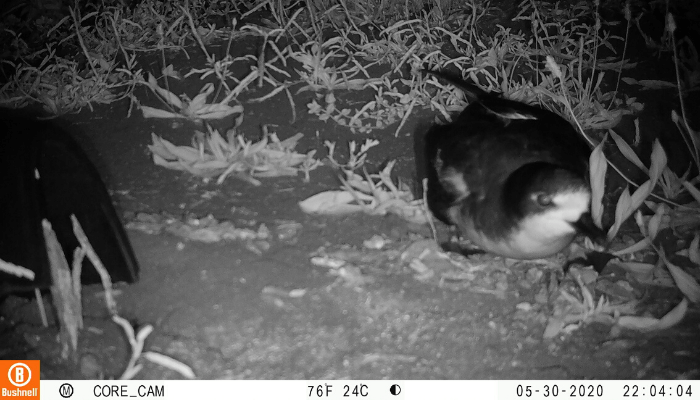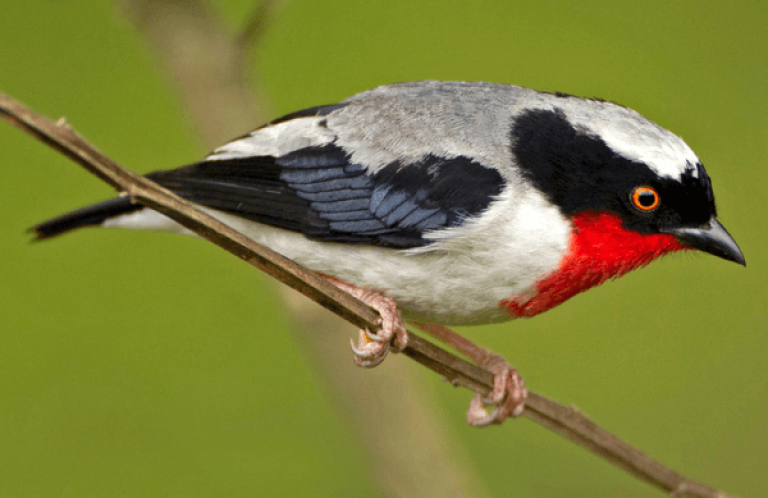After Years at Sea, Hawaiian Petrel Arrives Safely Home
UPDATE (SEPTEMBER 17, 2020): To date, a total of five banded Hawaiian Petrels have returned to the Nihoku Restoration site. These include one petrel from the 2016 cohort and the other four returnees from the 2017 cohort of translocated chicks. We've seen all birds inspect burrows and detected two pairs in burrows at the Nihoku restoration site.
UPDATE (AUGUST 11, 2020): Two banded Hawaiian Petrels have returned to the Nihoku Restoration site, the first from the 2016 cohort (band #1054-82103), and the second from the 2017 cohort of translocated chicks (band #1054-89077).
UPDATE (AUGUST 3, 2020): The returning Hawaiian Petrel began occupying an artificial nest box in July. The team confirmed the band number and now know that it was a female translocated as a chick to the Nihoku Restoration site.
Media Contact: Jordan Rutter, Director of Public Relations, 202-888-7472 | jerutter@abcbirds.org | @JERutter
Expert Contact: Hannah Nevins, Seabird Program Director, 808-333-4469| hnevins@abcbirds.org | @seabird_nerd

This trail camera photo captured the moment when a young Hawaiian Petrel, the first of 87 birds to have fledged from the site several years ago, returned to Nihoku. Conservation partners hope that this and other petrels will use the artificial nest boxes (such as the one on the left in this photo) to start a thriving new colony inside the predator-proof fence at Nihoku. Photo by Nihoku Ecosystem Restoration Project
(Kīlauea Point National Wildlife Refuge, Kauaʻi, Hawaiʻi, July 9, 2020) An historic effort to save the endangered Hawaiian Petrel (Pterodroma sandwichensis), or ʻUaʻu, has reached a critical milestone after years of anxious waiting by project partners: The first of 87 birds translocated as chicks and fledged from the protected haven of Nihoku at Kīlauea Point National Wildlife Refuge has returned after several years at sea. The sighting of this individual, via trail camera footage, is an early sign that this and other young birds that fledged from Nihoku between 2015 and 2019 successfully imprinted on the site and now may start returning to breed, just as conservationists had anticipated. Project partners hope that additional individuals will be lured in by the use of “social attraction” — with the species' calls played over a sound system — and that they will make use of artificial nest boxes installed within the protective fencing. The ultimate goal is to establish a thriving, new colony safe from predators.
After chicks leave the nest burrow, Hawaiian Petrels and many other seabirds typically spend several years foraging on the high seas as they mature to breeding age, then return to breed at the site where they fledged. This returning Hawaiian Petrel appears to have done just that. It was spotted during an early July review of trail camera footage periodically checked by project partners; the bird's visit to Nihoku occurred on May 30. The presence of leg bands on the bird confirm a high probability that this is one of the birds translocated to Nihoku four or five years ago.
“We are thrilled to learn of this bird's return,” said Dr. Lindsay Young, Executive Director of Pacific Rim Conservation. “This is an indication that our efforts in the translocation project to bring chicks to imprint on the site is bearing fruit, providing the right cues that lead birds to this safe haven. The ultimate goal is to establish a thriving breeding colony of Hawaiian Petrels within the fully enclosed fenced area, to protect the breeding birds from invasive predators. This petrel marks the first critical step toward achieving that outcome.”
3
The Nihoku Ecosystem Restoration Project is a multi-partner effort involving Pacific Rim Conservation (PRC); the Kaua‘i Endangered Seabird Recovery Project (KESRP); Hono O Nā Pali Natural Area Reserve (HONP NAR) Hawai‘i Department of Land and Natural Resources Division of Forestry and Wildlife (DOFAW); University of Hawaiʻi at Mānoa Pacific Cooperative Studies Unit; the Kīlauea Point National Wildlife Refuge; U.S. Fish and Wildlife Service; and American Bird Conservancy (ABC).
The project is part of a larger, island-wide effort to restore populations of the Hawaiian Petrel and another threatened and culturally important species, Newell's Shearwater (Puffinus newelli), or ʻAʻo. As was done in this project, translocating birds to protected habitats, from locations where they are vulnerable to threats such as invasive predators, is one important approach that is being implemented to help recover declining populations of Hawaiian seabirds. Other tactics include control of invasive predators, habitat management, fencing, reducing power line collisions, and fostering awareness within the island community on the issue of light attraction's fatal effects on seabirds. Both petrels and shearwaters can become disoriented by light during their fledging flights and thus are highly vulnerable to collisions.
Dr. André Raine, project leader for the KESRP team, monitors seven nesting areas in Kauaʻi's remote mountains and says there have been major population declines in the two species, with the Hawaiian Petrel declining by 78 percent and Newell's Shearwater by 94 percent between 1993 and 2013.
Over the last five years, the KESRP team has located and monitored ʻUʻau and ʻAʻo burrows in the mountains, then transported vulnerable chicks via helicopter to Nihoku just before the critical stage when they become imprinted on the new site to which they will later return to nest. The translocated chicks are fed by Pacific Rim Conservation's animal care team, which provides feeding, care, and monitoring of the chicks until they fledge from the site and head out to sea.
Since 2015, the team has successfully fledged 87 Hawaiian Petrels and 67 Newell's Shearwaters from Nihoku. The ultimate proof that the project is successful will be the presence of breeding pairs at the site — a milestone that the project partners are eagerly awaiting.
“After so many years of hard work in the mountains and at Nihoku by everyone in this project, it is hard to put into words exactly how exhilarating it is to see this special bird appear on camera at the site,” said Dr. Raine. “I literally jumped out of my seat and yelled with excitement when I saw the image for the first time, startling everyone around me! Considering all of the threats this species faces on Kauaʻi, their future on the island will only be assured if we use every conservation tool in our arsenal, including creative techniques like the translocation and social attraction project at Nihoku.”
"We are thrilled to reach such a momentous occasion in this ongoing important recovery project,” said Heather Abbey Tonneson, Refuge Manager for the Kaua‘i National Wildlife Refuge Complex. “We look forward to continuing to work closely with our partners on this project to help our endangered seabird populations soar toward recovery.”
“This is a huge step forward, and more confirmation that Hawaiian birds can be saved with effort and creativity,” said ABC President Mike Parr. “It's been a long wait to see the first petrel return to the protected habitat, but the science said it would. A new nest and chick would be an even bigger cause for celebration. That's what we hope will be next.”
“The return of the first translocated Hawaiian Petrel to the Nihoku site at Kīlauea Point National Wildlife Refuge is an incredibly important milestone for this partnership,” said Jeff Trandahl, Executive Director and CEO of National Fish and Wildlife Foundation (NFWF), a long-time supporter of this project. “This sighting also provides initial evidence that the protected location is attractive to returning translocated petrels and shearwaters, and hopefully will ultimately result in nesting and the establishment of the first fully protected coastal colony for these species in Hawai‘i.”
ABC and the partners are extremely grateful to the National Fish and Wildlife Foundation for helping to launch the translocation project in 2012, and for supporting the project every year since. We also deeply appreciate the long-term support of this project by the David and Lucile Packard Foundation, Lynn and Stuart White, the Martin Foundation, and Marge Duncan. The Kaua‘i Island Utility Cooperative provided critical support for predator control in collaboration with DOFAW in montane nesting areas within the Hono O Na Pali Natural Area Reserve, and the National Tropical Botanical Garden (NTBG) at Upper Limahuli Preserve. NTBG also undertook vegetation restoration at Nihoku. The project takes place within the management and protection of the Hono O Na Pali Natural Area Reserve, and the Kaua‘i DOFAW Natural Area Reserve team provides on-the-ground support.
###

Press Contacts:
Jordan Rutter, Director of Public Relations, American Bird Conservancy 202-888-7472 | jerutter@abcbirds.org | @JERutter
Lindsay Young, Executive Director, Pacific Rim Conservation, lindsay@pacificrimconservation.org
André Raine, Project Lead, Kaua‘i Endangered Seabird Recovery Project, araine6@hawaii.edu
Jennifer Waipa, U.S. Fish and Wildlife Service, Kīlauea Point National Wildlife Refuge, jennifer_waipa@fws.gov
Dan Denison, Senior Communications Manager, Department of Land and Natural Resources (DLNR), (808) 587-0407, dan.w.dennison@hawaii.gov
See project information: www.Nihoku.org
About the Partners:
American Bird Conservancy is a nonprofit organization dedicated to conserving birds and their habitats throughout the Americas. With an emphasis on achieving results and working in partnership, we take on the greatest problems facing birds today, innovating and building on rapid advancements in science to halt extinctions, protect habitats, eliminate threats, and build capacity for bird conservation. Find us on abcbirds.org, Facebook, Instagram, and Twitter (@ABCbirds).
Chartered by Congress in 1984, the National Fish and Wildlife Foundation (NFWF) protects and restores the nation's fish, wildlife, plants and habitats. Working with federal, corporate and individual partners, NFWF has funded more than 5,000 organizations and generated a total conservation impact of $6.1 billion. Learn more at www.nfwf.org.
Kīlauea Point National Wildlife Refuge was established in 1985 to preserve and enhance seabird nesting colonies and in 1988 was expanded to include Nihoku (Crater Hill) and Mōkōlea Point. To learn more about the refuge, please visit www.fws.gov/kilaueapoint. The U.S. Fish and Wildlife Service works with others to conserve, protect, and enhance fish, wildlife, plants, and their habitats for the continuing benefit of the American people. For more information, visit www.fws.gov.
Pacific Rim Conservation (PRC) is an independent organization dedicated to studying and conserving the biota of the Pacific region. PRC provides biological research and management services to government agencies, non-profit organizations, landowners, and a variety of other groups throughout the Hawaiian Islands and the Pacific region. PRC's goal is to maintain and restore native species and ecosystems through habitat protection and management, threat control, public education, and scientific research to develop and improve conservation methods.
The Kauaʻi Endangered Seabird Recovery Project (KESRP) is a Department of Land and Natural Resources Division of Forestry and Wildlife project, administered through the Pacific Studies Cooperative Unit of the University of Hawaiʻi. Formed in 2006, the project focuses primarily on the three endangered seabirds found on the island of Kauaʻi -Newell's Shearwater, Hawaiian Petrel and Band-rumped Storm-petrel. KESRP's work involves identifying the breeding distribution of these rare and enigmatic seabirds, monitoring their breeding colonies, undertaking research projects to better understand their life histories and the various threats which they face, and working with partner projects and organizations to ensure their long-term conservation. For more information visit http://kauaiseabirdproject.org/ and the Kaua‘i Endangered Seabird Recovery Project Facebook page.
Hono O Nā Pali Natural Area Reserve encompasses 3,579 acres or 1,448 hectares on the island of Kaua‘i protecting the main nesting areas of the ʻUʻau and ʻAʻo, and many other rare species of plants and animals. The Reserve was designated in 1983 and expanded in 2009 to preserve native natural communities in the Hanalei and Waimea Districts, including the Hanakāpī‘ai, Hanakoa, and Waiahuakua ahupua‘a. The Reserve stretches from sea level along the picturesque Nā Pali coast to the highest point at Pihea of 4,284 feet or 1,306 meters. The Reserve encompasses parts of Hanakāpī‘ai and Hanakoa streams and all of Waiahuakua Stream; the southern boundary of the NAR is the south side of the Alaka‘i Swamp Trail. The Reserve includes perennial streams, riparian and ridgeline habitat, lowland and montane forests, rare plants, endemic stream fauna, and forest bird and seabird habitat. Visit the HONP NAR website.


















































